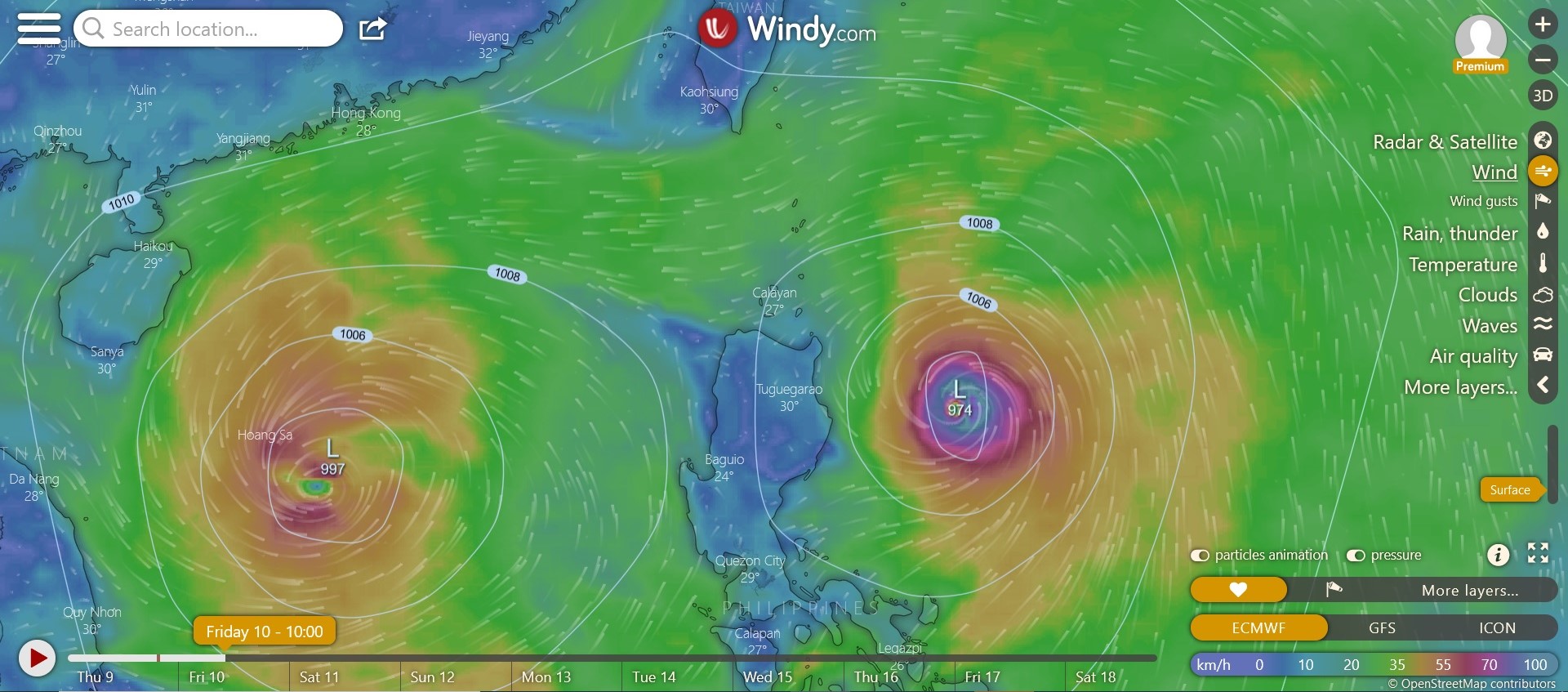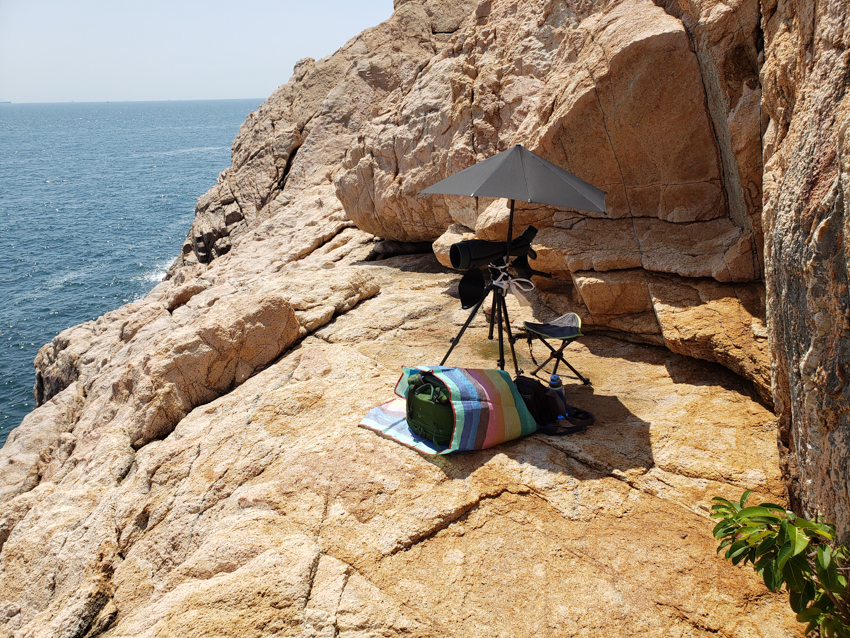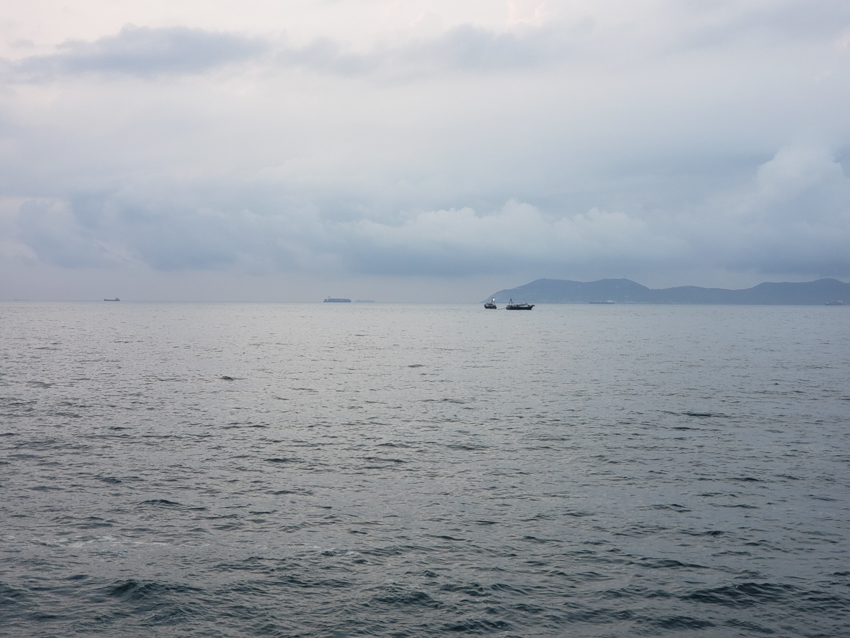9 to 11 September
Here we are with the first survey of the autumn, i.e. September, October and November. There have been few seawatching surveys in the past during autumn and winter (much more during April and May) and I even don’t know of anybody ever doing seawatching a whole day long with a telescope at Nam Kok Tsui. So there is a lot of new data that we can gather.
The reason to go from 9 to 11 was the prediction of this weather system, which looked like a dream for a seawatcher:


This were the predictions for Friday 10th at 10 AM. Left is Severe Tropical Storm Conson and right is Super Typhoon Chanthu.
9 September was the first day of this survey, and I started soon after arriving with the ferry, as usual. I watched from 11h45 to 17h45. The weather was fine, with east to northeast winds, force 2 to 3. The afternoon saw the passage of mostly terns. It is likely that at least the same number passed during the early morning. Alas many were very far out.
Interesting is to note that I did not see a single tern from the ferry from Aberdeen to Po Toi. This strongly indicates that the ferry trip provides no indication for what to see at Nam Kok Tsui, as the migration route of birds is far away from the ferry route.
Gulls:
1 adult-type large white headed gull; very far also, but appeared to have a rather light mantle, lighter than Heuglin’s Gull
Terns:
866 terns spec.
80 Common Terns
32 Greater Crested Terns
20 White-winged Terns, 1 group
1 Little Tern
Here’s the checklist:
https://ebird.org/checklist/S94539414
So Friday
10 September was the day that looked fantastic from the predictions, with winds up to force 6. It would be “mainly cloudy with occasional squally showers and thunderstorms”. Okay for me, as I’ve seen shearwaters in that kind of weather in Hong Kong, so bring it on.
Alas, the reality was quite a bit different. Apart from some scattered clouds in the morning but not a drop of rain, it turned-out to be hot and sunny for most of the day. Winds coming from the east and northeast, but only force 3 to 4. During noon, shortly force 5.
I had to make a construction with my umbrella against the sun, not against showers and thunderstorms.


Not a single tubenose was seen, but tern movement was massive. As soon as I put my scope at the sea, I witnessed these birds flying west. I think I counted over a 100 in the first 10 minutes and soon after up to 300 in just 15 minutes. My voice recorder proved to be very valuable, as I was able to count and record without taking my eye from the sea.
The peak of tern movement was between 06h00 and 09h30, but they kept on coming for most of the day.
I’ve probably missed some terns, as it happened frequently that when I zoomed-in to 70x from 30x to try to identify the distant birds, I discovered that there were even more terns passing further out that were invisible with 30x magnification.
Seabirds:
11 jaegers spec, groups of 2 and 9
Egrets:
21 white egrets spec.
Waders:
3 Red-necked Phalaropes, flying northeast
Terns:
2,969 terns spec.
165 Greater Crested Terns, 161 flying west, 4 to northeast
56 Common Terns
33 Aleutian Terns
3 Bridled Terns
There were also some passerines on the move and 1 swift, but I focused on the terns. Here’s the checklist:
https://ebird.org/checklist/S94539495
11 September was again a pretty good day, but it appeared that the largest number of terns had moved through. The majority on this day occurred between 06h00 and 08h00, with very few afterwards. It was cloudy in the morning with one distant thunderstorm, but soon turned really very hot and sunny. Winds coming from the west now, force 2 to 3.
Seawatchers need FOPP – focus, optimism, patience and perseverance. Even though it turned really hot and there was not much movement, another good species flew-by at 10h37 and FOPP was rewarded. But I must admit that the weather and the observation that most terns passed-through at that point, eventually made me quit earlier than planned.
Seabirds:
1 Swinhoe’s Storm Petrel, flying to northeast at 10h37
Egrets:
47 white egrets spec.
46 Little Egrets
14 Eastern Cattle Egrets
Gulls:
2 Heuglin’s Gulls
Terns:
1,207 terns spec.
100 Greater Crested Terns, 96 flying west, 4 to northeast
37 Common Terns
22 Aleutian Terns
7 White winged Terns, 1 group
1 Gull-billed Tern
1 Bridled Tern
Here’s the checklist:
https://ebird.org/checklist/S94539547
Remarks
Once more a very worthwhile and most enjoyable survey. I can only repeat that this place is awesome.
A total of exactly 5,600 terns were counted on one full and two half days (only!).
For Greater Crested Terns, we set a new record high count for Hong Kong with 165 individuals seen. The previous record was 105 last April, but only with counts during early morning and late afternoon, not during the whole day.
This species is one of the best examples of how the status of a bird can be different from reality. The status in Hong Kong up to now is “Common spring passage migrant through coastal waters with occasional summer and autumn records.”. What is really occasional in summer and autumn is not the occurrence of this species, but birders looking for them. Of course, the status of a bird can only be determined with what’s been seen and reported, but this illustrates that too few observation days can lead to an inaccurate status. Greater Crested Tern is common in spring, not uncommon in summer and it looks like to be common in autumn as well. But let’s first get some more observation days for the autumn.
Something similar can be said about terns in general. Record counts of Common Tern and Aleutian Tern have been reported during typhoons in spring (mainly typhoon Leo on 2 May 1999, from Cape D’Aguilar). But our survey here produced 5,600 terns without any typhoon near Hong Kong. The two storms mentioned above were actually quite far away and not even a storm signal 1 was issued in Hong Kong during the survey. Yet thousands of terns passed-through. Although weather conditions might have an effect, we don’t necessarily need a typhoon. More likely there was just a normal, regular passage at the right time in autumn.
It’s indeed a pity that so many terns flew very far out, and more so that I was unable to identify the majority. Firstly, when more Common Terns than Aleutian Terns (or vice versa) were counted, that doesn’t mean there were really more Common than Aleutian, just that the birds that flew close enough for a positive ID happened to be Common. But I did feel that Common were the majority, but can’t be really sure.
Secondly, on Saturday 11th and for a limited time, some terns suddenly flew a lot closer than on the previous days. Two fishing boats relatively nearby, with their nets in the water, seem to attract the terns.


It’s interesting to note that this caused the migration route to be different – after the boats were gone, terns flew far off again. It could be a useful fact when doing boat trips for observing birds: any kind of fish-based chum will most probably (at least) attract many terns, even more likely during migration time.
I’m looking forward to future autumn surveys and am expecting an increase in species of a broader variety of families of birds, like herons, egrets, gulls, ducks, grebes, waders, etc., but also swifts, swallows, passerines and raptors. I will miss most of the ones that fly high, as I will continue to focus on seawatching.
[
Last edited by badesc at 13/09/2021 11:35 ]


